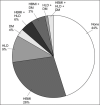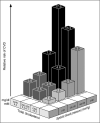Blood pressure control in patients with comorbidities
- PMID: 18772645
- PMCID: PMC8110138
- DOI: 10.1111/j.1751-7176.2008.08172.x
Blood pressure control in patients with comorbidities
Abstract
Hypertension frequently coexists with obesity, diabetes, hyperlipidemia, or the metabolic syndrome; their association with cardiovascular disease is well established. The identification and management of these risk factors is an important part of the overall management of hypertensive patients. Because patients in these special populations are more predisposed to target organ damage (TOD), stringent targets for blood pressure (BP) control have been set in clinical guidelines. However, clinical trial and real-life evidence suggest that these targets are difficult to achieve. Patients with these comorbidities are more likely to require combination therapy, yet physicians are often reluctant to adjust the number and doses of medications to achieve target BP. There is a particular need for effective 24-hour BP control in these patients, due to the increased likelihood of nondipping status, which is a risk factor for TOD and mortality. Not all available antihypertensives are equally effective in controlling BP over 24 hours, and some may exacerbate underlying metabolic abnormalities.
Figures




Similar articles
-
Risk factors for cardiovascular diseases in patients with vitiligo: an analysis of current evidence.Ann Med. 2024 Dec;56(1):2326297. doi: 10.1080/07853890.2024.2326297. Epub 2024 Sep 19. Ann Med. 2024. PMID: 39300810 Free PMC article.
-
Contributory Risk and Management of Comorbidities of Hypertension, Obesity, Diabetes Mellitus, Hyperlipidemia, and Metabolic Syndrome in Chronic Heart Failure: A Scientific Statement From the American Heart Association.Circulation. 2016 Dec 6;134(23):e535-e578. doi: 10.1161/CIR.0000000000000450. Epub 2016 Oct 31. Circulation. 2016. PMID: 27799274 Review. No abstract available.
-
Blood pressure control and components of the metabolic syndrome: the GOOD survey.Cardiovasc Diabetol. 2009 Sep 15;8:51. doi: 10.1186/1475-2840-8-51. Cardiovasc Diabetol. 2009. PMID: 19754934 Free PMC article.
-
Metabolic syndrome: cardiovascular risk assessment and management.Am J Cardiovasc Drugs. 2007;7(4):259-72. doi: 10.2165/00129784-200707040-00004. Am J Cardiovasc Drugs. 2007. PMID: 17696567 Review.
-
Association of Psoriasis With Comorbidity Development in Children With Psoriasis.JAMA Dermatol. 2018 Mar 1;154(3):286-292. doi: 10.1001/jamadermatol.2017.5417. JAMA Dermatol. 2018. PMID: 29322175 Free PMC article.
Cited by
-
Olmesartan/amlodipine/hydrochlorothiazide in participants with hypertension and diabetes, chronic kidney disease, or chronic cardiovascular disease: a subanalysis of the multicenter, randomized, double-blind, parallel-group TRINITY study.Cardiovasc Diabetol. 2012 Oct 30;11:134. doi: 10.1186/1475-2840-11-134. Cardiovasc Diabetol. 2012. PMID: 23110471 Free PMC article. Clinical Trial.
-
Predictors of non-adherence to antihypertensive medications: A cross-sectional study from a regional hospital in Afghanistan.PLoS One. 2023 Dec 27;18(12):e0295246. doi: 10.1371/journal.pone.0295246. eCollection 2023. PLoS One. 2023. PMID: 38150430 Free PMC article.
-
Fixed-Dose Combination Formulations in Solid Oral Drug Therapy: Advantages, Limitations, and Design Features.Pharmaceutics. 2024 Jan 26;16(2):178. doi: 10.3390/pharmaceutics16020178. Pharmaceutics. 2024. PMID: 38399239 Free PMC article. Review.
-
Atherogenic dyslipidemia and associated risk factors among hypertensive patients of five health facilities in Northeast Ethiopia.PLoS One. 2023 Feb 14;18(2):e0277185. doi: 10.1371/journal.pone.0277185. eCollection 2023. PLoS One. 2023. PMID: 36787318 Free PMC article.
-
Moderate versus intensive treatment of hypertension using amlodipine/valsartan and with the addition of hydrochlorothiazide for patients uncontrolled on angiotensin receptor blocker monotherapy: results in racial/ethnic subgroups.J Am Soc Hypertens. 2011 Jul-Aug;5(4):249-58. doi: 10.1016/j.jash.2011.02.007. Epub 2011 Apr 8. J Am Soc Hypertens. 2011. PMID: 21482217 Free PMC article. Clinical Trial.
References
-
- Weycker D, Nichols GA, O'Keefe‐Rosetti M, et al. Risk‐factor clustering and cardiovascular disease risk in hypertensive patients. Am J Hypertens. 2007;20:599–607. - PubMed
-
- Alberti KG, Zimmett P, Shaw J. The metabolic syndrome: a new worldwide definition. Lancet. 2005;366:1059–1062. - PubMed
-
- Third report of the National Cholesterol Education Program (NCEP) Expert Panel on Detection, Evaluation, and Treatment of High Blood Cholesterol in Adults (Adult Treatment Panel II) . Final Report. Circulation. 2002;106:3143–3421. - PubMed
-
- Ford ES, Giles WH, Dietz WH. Prevalence of the metabolic syndrome among US adults. Findings from the Third National Health and Nutrition Examination Survey. JAMA. 2002;287:356–359. - PubMed
Publication types
MeSH terms
Substances
LinkOut - more resources
Full Text Sources
Medical

